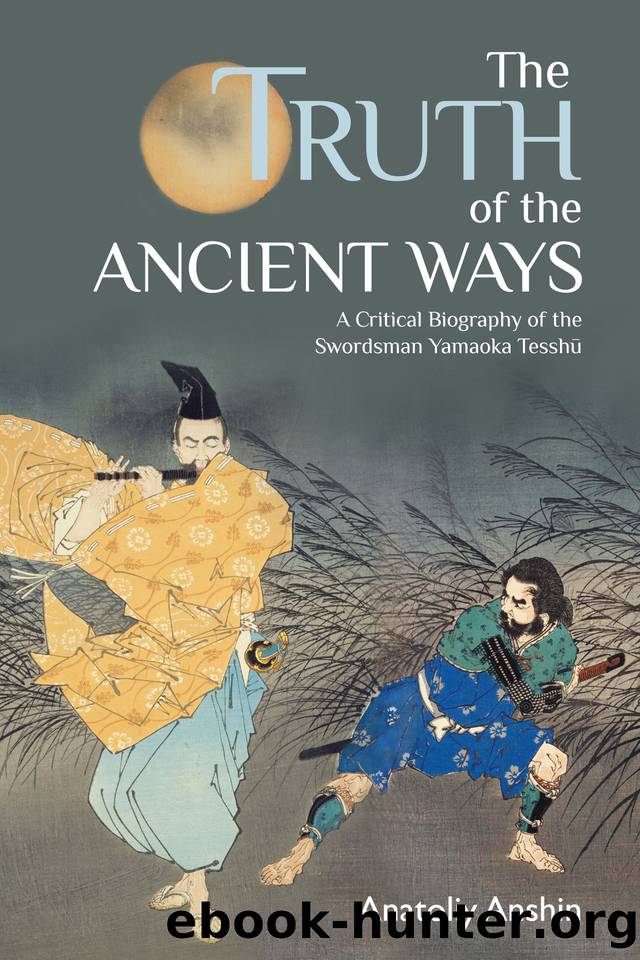The Truth of the Ancient Ways: A Critical Biography of the Swordsman Yamaoka Tesshu by Anshin Anatoliy

Author:Anshin, Anatoliy [Anshin, Anatoliy]
Language: eng
Format: epub
Publisher: Kodenkan Institute
Published: 2019-04-14T16:00:00+00:00
Chapter 4
âThe Truth of the Ancient Waysââ The Beginning of the Quest
Ten Fists
Y amaokaâs stance on the turmoil in the internal politics of the Bakumatsu period may be characterized as aloofness, and the only evidence of his involvement in political events of the time was his minor affiliation with the Society of the Tigerâs Tail (1860â1861) and his short-term participation in the RÅshigumi affair (December 1862 â April 1863), which were discussed in the previous chapter. Instead, in the late 1850s and 1860s, he devoted as much time as possible to his own musha shugyÅ , as well as to teaching swordsmanship at the Military Institute. Yamaokaâs aloofness with regard to politics may be explained by his belief that participation in political struggles and intrigues would inevitably put him at risk of misusing his swordsmanship skills with the consequent unnecessary loss of human life. This was against his moral principles (and religious conscience) and contradicted the very foundations of his musha shugyÅ , which strove for the ideal of the âlife-giving sword.â Yamaoka does not appear to have ever explicitly used the term âlife-giving sword,â but, in one of his writings on swordsmanship, he stated that âa swordsman who pursues the [ultimate] truth of swordsmanshipâ must avoid bloodshed. 1 Furthermore, the fact that there is no evidence that, as a senior swordsman, he was entangled in any kind of bloodshed in the Bakumatsu turmoil may be regarded as the direct realization of the concept of the âlife-giving sword.â
As noted earlier, Yamaoka held the chÅ«mokuroku menkyo rank of Hokushin IttÅ-ryÅ« swordsmanship. This gave him the right to establish his own branch training hall and have disciples. However, he chose to reject this. By this time, he had already started to question the practicability of Hokushin IttÅ-ryÅ« sword skills in actual combat. From Yamaokaâs point of view, Chiba ShÅ«sakuâs âmodernizationâ and ârationalizationâ now seemed to be nothing more than a distortion of the original IttÅ-ryÅ« tradition. In another writing on swordsmanship, Yamaoka even criticized Chibaâs famous match with Åishi Susumu, which took place in the early 1830s. Implicitly pointing to the fact that Chibaâs whole technical system was removed from the realities of the battlefield, he wrote:
A match between Åishi Susumu and Chiba ShÅ«saku was held. They say that Åishi used the bamboo sword of more than five shaku long, 2 and to oppose him Chiba used as a guard of his bamboo sword a lid of a large barrel. 3 Their match was a mere lark, and was not what I call âswordsmanship.â 4
Written criticism of the founder of a contemporary swordsmanship school, especially a school that was one of the most famous in the Bakumatsu period and early Meiji era, was extremely rare. This shows the degree to which Yamaoka was upset with what he saw as the deviation of Hokushin IttÅ-ryÅ« from his standards of the genuine warrior culture.
Nor was Yamaoka satisfied with what he saw at other private swordsmanship training halls or the Bakufu Military Institute, and his
Download
This site does not store any files on its server. We only index and link to content provided by other sites. Please contact the content providers to delete copyright contents if any and email us, we'll remove relevant links or contents immediately.
| Africa | Americas |
| Arctic & Antarctica | Asia |
| Australia & Oceania | Europe |
| Middle East | Russia |
| United States | World |
| Ancient Civilizations | Military |
| Historical Study & Educational Resources |
Magic and Divination in Early Islam by Emilie Savage-Smith;(1492)
Ambition and Desire: The Dangerous Life of Josephine Bonaparte by Kate Williams(1329)
Bohemians, Bootleggers, Flappers, and Swells: The Best of Early Vanity Fair by Bohemians Bootleggers Flappers & Swells- The Best of Early Vanity Fair (epub)(1325)
Papillon by Henry Charrière(1298)
Twelve Caesars by Mary Beard(1232)
Operation Vengeance: The Astonishing Aerial Ambush That Changed World War II by Dan Hampton(1128)
What Really Happened: The Death of Hitler by Robert J. Hutchinson(1114)
London in the Twentieth Century by Jerry White(1098)
Time of the Magicians by Wolfram Eilenberger(1074)
Twilight of the Gods by Ian W. Toll(1072)
The Japanese by Christopher Harding(1068)
Lenin: A Biography by Robert Service(1028)
The Devil You Know by Charles M. Blow(973)
A Social History of the Media by Peter Burke & Peter Burke(926)
Freemasons for Dummies by Hodapp Christopher;(911)
Napolean Hill Collection by Napoleon Hill(890)
Henry III by David Carpenter;(882)
The Churchill Complex by Ian Buruma(874)
The Rise and Triumph of the Modern Self by Unknown(872)
